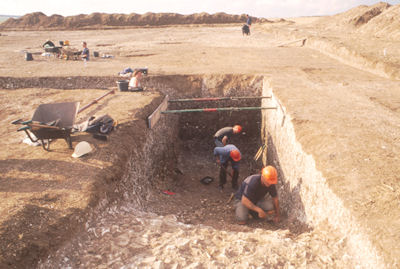Cottam A: a Romano-British and Anglian Settlement in East Yorkshire
Julian D Richards, 2011. https://doi.org/10.5284/1000132. How to cite using this DOI
Data copyright © Prof Julian D Richards unless otherwise stated
This work is licensed under a Creative Commons Attribution 4.0 International License.
Primary contact
Prof
Julian D
Richards
Department of Archaeology
University of York
King's Manor
Exhibition Square
York
YO1 7EP
England
Tel: 01904 433901
Fax: 01904 433902
Resource identifiers
- ADS Collection: 994
- DOI:https://doi.org/10.5284/1000132
- How to cite using this DOI
Overview
This digital archive complements the synthetic publication of Cottam A, published as "Cottam, Cowlam and environs: An Anglo-Saxon estate on the Yorkshire Wolds" in The Archaeological Journal (forthcoming). It comprises a number of different elements, all of which are available from the downloads page:
(a) Seven unpublished archive reports:
- Fieldwalking at Cottam 1994 (COT94F), by T.Austin & E.Jelley, 2009
- Cottam A: An evaluation of the vertebrate animal remains. Archive report, by P.Excell, edited by J.D.Richards 2009
- Cottam A: Excavations in 1996 (COT96E) The Pottery, by E.Jelley and T.Austin, 2007
- Cottam A: Excavations in 1996 Archive Report, by J.D.Richards, 1997
- Cottam A: Coin catalogue, by J.Booth, 2009
- Cottam A: Metalwork catalogue, D.Haldenby, 2009
- Cottam A: Worked bone and antler, by S.Ashby, 2011

(b) Four data files:
- Fieldwalking finds.
During the winter of 1994 students from the Department of Archaeology undertook fieldwalking supervised by Andrew Copp. A total of 48 30-metre squares were systematically walked with the squares forming a large 8 (240 m) x 6 (180 m) rectangle in the field directly north and west of Cottam Grange. The base line for this rectangle ran parallel with a hedge line directly west of the Grange. The patterning of the Iron Age and Roman material suggests evidence of increasing activity towards the hedge line. The significant amounts of slag towards the southern corner of the survey area suggest some sort of undated metal working activity in the vicinity. The grid squares G1-O6 refer to the 30m squares as mapped in the unpublished fieldwalking report above (Austin and Jelley 2009). - Coins database.
This comprises of excavated and metal-detected coins, as above. Coin identification is by James Booth at the University of Hull. In both the metalwork and coins databases the finds id numbers are those used in the published report. The 'Present location' field indicates the Hull Museum accession number or 'private possession' for metal-detected finds; excavated finds are referenced by context and small-find numbers. - Metalwork database.
This comprises of finds excavated in 1996 and metal-detector finds made largely by D.Haldenby, D.Hirst and S.Foster from the mid 1980's onwards. - Excavated pottery database.
Of 1015 sherds examined the majority (940 sherds, or 92.6%) were late Iron Age or Roman in date, predominately consisting of calcite gritted wares and East Yorkshire grey wares, with smaller quantities of Samian ware. Context numbers are those used in the archive report above (Richards 1997). For ware descriptions see the pottery report (Jelley and Austin 2007). Finds ids are those allocated on site, and in some cases comprise groups of more than one sherd. Eastings, Northings and Height are based upon the site grid and datum.
(c) Colour photographs of 185 metal artefacts and 28 coins, as catalogued in the database files. Only the Anglo-Saxon metalwork and coins have been published, so this archive represents the primary record of the metal finds of other periods (principally Roman) recovered by excavation or metal-detecting.
(d) Magnetometer unprocessed data file. The survey was undertaken by Justin Garner-Lahire between 18 March and 12 April 1996. The aim was to produce a detailed map of sub-surface magnetic anomalies within a 100 x 100 m sample area positioned to coincide with the concentration of metal objects located during the metal detector survey. The survey was carried out using a FM18 fluxgate gradiometer. Each 20 x 20 m survey grid was undertaken using the parallel transverse method (unidirectionally) to ensure the capture of good quality raw data. Instrument readings were logged at 0.5 x 0.25 m intervals. Each record in the data file comprises an easting, northing and instrument reading.





